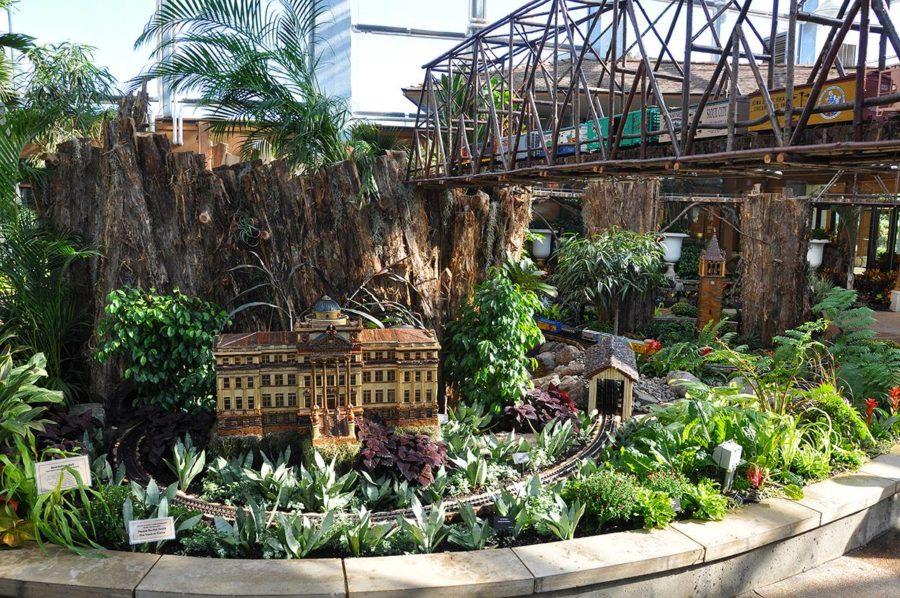Train display returns to Reiman Gardens
December 5, 2019
A festive display has returned to Reiman Gardens for another holiday season.
The Reiman Gardens RG Express train is back again this winter, marking its fifth appearance at the gardens. It was first started at Iowa State in the winter of 2015.
The RG Express train is an extensive exhibit located in the Hughes Conservatory that took 60 people and more than 500 hours of work to set up.
“The actual tracks themselves cannot be changed because they are built to site,” said Ed Lyon, director of Reiman Gardens. “There are structures we call mountains; they change every year. There are always water features and plant material that changes.”
The train runs on two tracks, an upper and lower, that wind through a miniature Iowa State campus scene along with a few familiar pieces from the gardens itself.
“The buildings are the same every year,” Lyon said. “This is a very specific garden railway built by a group in Kentucky called Applied Imagination. There are only 17 such garden railways in North America. What makes it unique is all of the structures are made from natural material.”
This year, the train display not only boasts small scale versions of iconic landmarks that dot the Iowa State campus — including the Campanile, which actually plays music in the exhibit, and Beardshear Hall — but also brings something new to the table. The train’s new addition for this season is the butterfly wing from Reiman Gardens.
The Christina Reiman Butterfly Wing has been a part of the Gardens since 2002, according to the Reiman Gardens website. It is a 2,500 square foot enclosure that can house as many as 800 butterflies at a time. Nectar from over 300 tropical plants, with a range of 30 different families and 70 varieties, provide the inhabiting butterflies with plenty of food.
Materials for the model Butterfly Wing include birch sticks, horse chestnut bark, natraj sticks, rose of Sharon sticks, grapevine, winged euonymus, driftwood, turkey tail fungus, willow sticks, sinocalycanthus pod and dried flora, according to the Reiman Gardens website.
As for some of the unique included buildings from around campus, the Hub is one of them. Back in 1891 when Ames was not yet the large campus town it is today, it had a train known as “the Dinkey” that ran in front of it to help students and staff get to and from campus.
The Dinkey used to cost five cents per ride and also transported coal and mail in addition to people until it was replaced with an electric streetcar in 1907. Now the Hub serves as a cafe for students and staff to enjoy. However, the RG Express train display takes the Hub back to its roots with a working miniature version of the Dinkey that runs in front of it.
The miniature Hub is made from driftwood, cedar, bamboo, birch bark, grapevine, contorta pine and kiwi vine, according to the Reiman Gardens website.
The exhibit Campanile plays music just like the real one does. The songs it plays, including “The Bells of Iowa State,” “ISU Fights” and “Go, Cyclones, Go!,” are from a recording of carillion music played by Tin-Shi Tam, one of the university’s music professors, according to the Reiman Gardens website.
Materials for the model campanile include grout and sand, tiny gourds for the bells, pine cone scales on the roof, cinnamon curls, honeysuckle vine, elm, birch bark, white tallow berries, tiny dawn redwood pine cones and more, according to the Reiman Gardens website.
Other models include the Marston Water Tower, Beardshear Hall, Morrill Hall and a two-foot replica of Elwood, Reiman Gardens’ giant concrete gnome.
“All of the railways are reflective of the community that they are in, and we opted for campus buildings,” Lyon said. “These replicas are considered art pieces and are insured as art pieces. They cost us upwards to $14,000 dollars per building. We do not change out the buildings every year, but we do hope to add new ones.”
Open since Nov. 24, the exhibit will be displayed for just over two months until Jan. 4, with a few exceptions such as Christmas Day and New Year’s Day.
Reiman Gardens is open from 9 a.m. to 4:30 p.m daily. Admission is $9 for those aged 13 to 64, $4.50 for those aged three to 12 and free for members, Iowa State students and children of age two or younger.

















